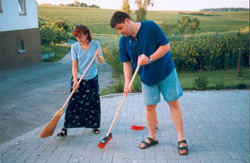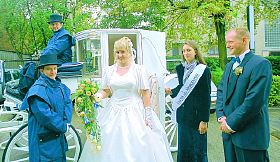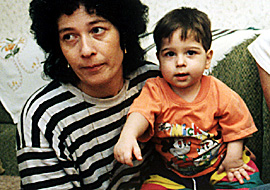3.9 German Families
The wedding (die Hochzeit)
A German wedding (die Hochzeit) is as lavish an occasion as it is in Britain, and one that incorporates a large number of traditions. Some of them will be familiar to us - for example the stag night (der Junggesellenabschied) during which the groom celebrates his last few hours of freedom by drinking himself into an alcoholic stupor with his friends. Less familiar however is der Polterabend, a party held at the bride's house on the eve of the wedding that literally translates as "an evening of making noise". And this is precisely what happens - wedding guests and other friends bring ceramic dishes (but no glass, as this brings bad luck!) and smash them on the ground to ward off evil spirits. The bride (die Braut) and groom (der Bräutigam) then clear up the pieces with a broom (see below), preferably together as this shows that they are willing to work as a team in bad times as well as good.
 |
| Sweeping up after a Polterabend |
|
Other differences to note are that German married couples wear their wedding ring (der Ehering) on their right hand. Both the bride and the groom wear simple gold bands that are very different to the diamond-encrusted wedding rings that are often found in Britain. The bride often carries salt and bread as an omen for good harvest, whereas the groom carries grain for good luck and wealth. Rice is thrown in the air as the happy couple leave the church and instead of the bride's bouquet, it is her veil that is passed on to the female guest who is next in line for marriage.
 |
| A traditional German wedding |
|
German wedding celebrations (die Hochzeitsfeier) vary from region to region and from town to region. In some rural areas, the bride is "kidnapped" before the marriage by friends and family and the groom has to search strategic locations to find her. As these locations invariably include local hostelries, the groom will buy drinks for any acquaintances that he might meet on his journey. In parts of North Germany the newlyweds return to their house to find that the doors have been barricaded shut and that all the furniture has been placed on the roof! Their first task as a a married couple is thus to rescue their furniture and get into their house without any outside help. In other rural areas, the first task of the bride and groom on leaving the church is to saw through a log using a 2-man log saw. Not very practical if you're wearing a wedding dress or a tuxedo...
Given the strenuous and expensive nature of a traditional wedding, it seems hardly surprising that an increasing number of Germans forsake the additional chuch ceremony (die kirchliche Trauung) and make do with a simple civil ceremony (die zivile Trauung) at a registry office (das Standesamt). This civil ceremony is required by law. The money thus saved can then be spent on on the honeymoon (die Flitterwochen).
To marry or not to marry?
As in other European countries, marriage (die Ehe) no longer holds such a central place in German society as it used to. Firstly, more marriages now end in divorce (die Ehescheidung) than ever before. In 1960, only 0.9 out of 1000 Germans had been part of a marriage that ended in divorce. By 1990 this figure had more than doubled to 1.9 per thousand inhabitants. One in three marriages now ends in divorce, with a record 194,408 divorces being registered in the year 2000.
Secondly, fewer Germans choose to get married in the first place. There were only 442,000 marriages in Germany in 1993 compared to 690,000 marriages in 1960. The decline in the number of marriages is particularly pronounced in the former GDR, where the number of marriages dropped by over 50 per cent between 1990 and 1993. This can be explained partially by the dramatic social changes in the former East Germany brought about by reunification and partially by the fact that under socialism many couples had chosen to marry primarily in order to secure better accommodation and child-care benefits.
More and more couples are choosing instead to live as non-married partners (der Partner; die Partnerin) in a so-called Lebenspartnerschaft (partnership for life), a relationship that is now recognised and protected by civil law. Between 1972 and 1990, the number of such households increased sevenfold, to 963,000, or 2.7 percent of all households. And by 1999 there were 2.1 million unmarried (unverheiratet) German couples living together which meant that one couple in ten did not have a marriage certificate. In the new German states and in the eastern part of Berlin, living together outside of marriage is very common: one couple in eight have no marriage certificate. Many of these are young couples who are choosing to live together before getting married. In 1992 the average age at first marriage had risen to 29.0 for men and 26.5 for women in the old Länder, compared with 27.1 for men and 25.1 for women in the new Lšnder.
To have children or not to have children?
Equally noticeable is the falling birth rate in Germany with more and more couples choosing not to have children. For about 25 years the birth rate has been one third below the level necessary to replenish the population. In 1950 the average number of persons in German households was 3.0. By 1990 this figure had declined to 2.3. In the early 1990s, only foreign families were regularly having two or more children, with the Turkish subgroup being the largest in terms of family size. The slump in the birth-rate has been particularly pronounced after reunification in the east of Germany where a combination of high female unemployment and the dismantling of the GDR's child-care system has dissuaded women from starting a family.
 |
| A German mother and child |
|
The Federal Government has become increasingly aware of the need to promote family life and as of 1 January 2001 new legislation governing child-raising benefit came into force, entitling both parents to apply for child-raising leave simultaneously and spend up to 30 hours a week in part-time work. The aim was to redress the traditional role division between the sexes whereby mothers typically stayed at home to look after their children, which had an adverse effect on their professional lives.
The one area in which marriage is on the increase is in the gay and lesbian communities. From August 2001 onwards, same-sex couples can marry in registry offices and enjoy all the rights that heterosexual spouses have in areas such as inheritance and health insurance. Foreign partners of German gays and lesbians are also now allowed to join them in Germany.
 |
| Motherhood, career or both? |
|
 Chapter 3.10: Vocabulary: The family Chapter 3.10: Vocabulary: The family
 Nach oben Nach oben
 Print This Page Print This Page
|